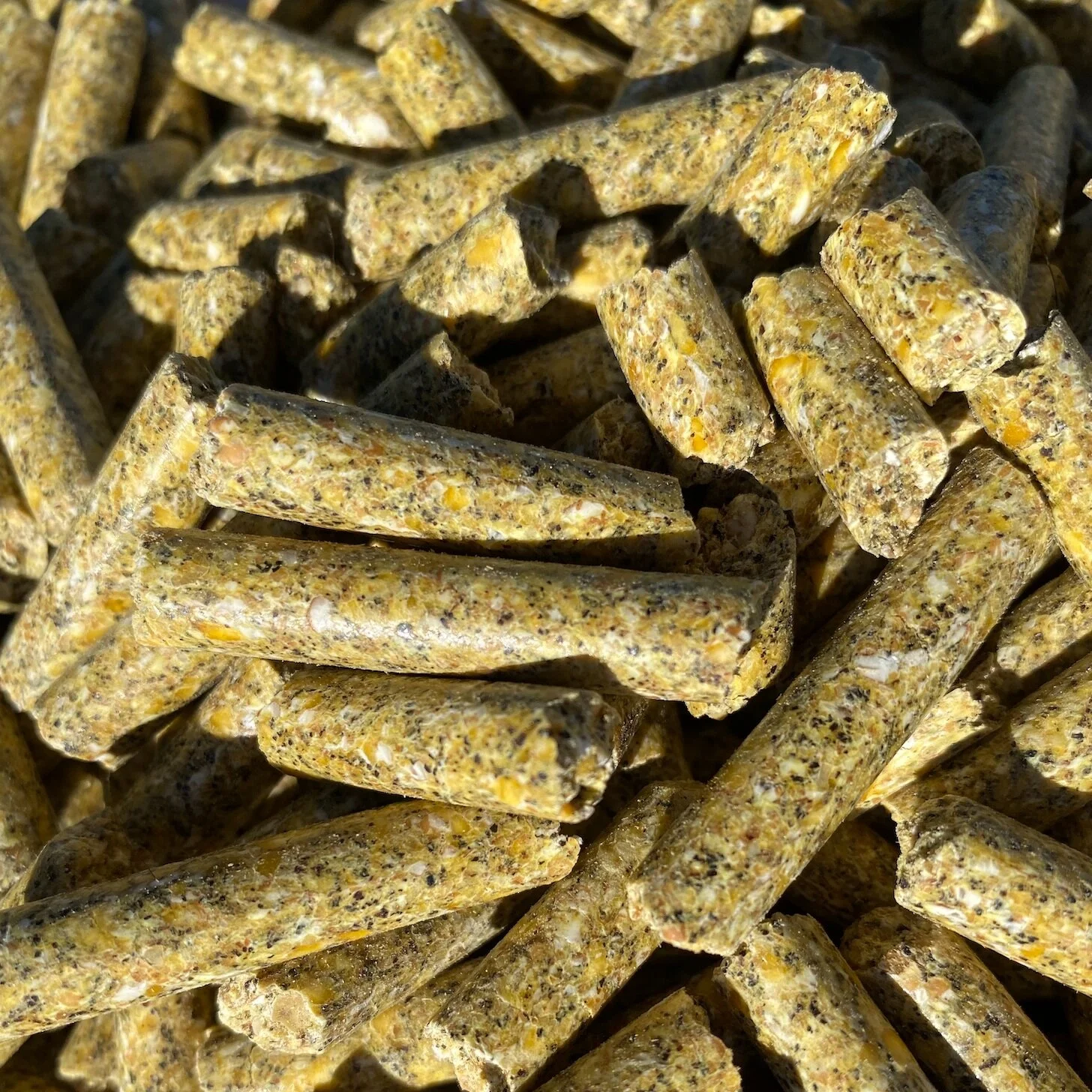Shop
Premium Ruminant Pellets
All in one pellet suitable for sheep and cattle. Includes essential vitamins and minerals with excellent buffering.
Size: Available in 4mm, 6mm and 7mm
Ingredients: Wheat, Barley, Lupins, Fiber, Vegetable Meal, Vitamins and Minerals. No Antibiotics.
Nutritional Value:
· CP: 14.8% on a DM (Dry Matter) basis
· 11.6 MJME/kg on a DM (Dry Matter) basis
Prices (ex GST):
· Bulk: $460/tonne ($0.46/kg)
· Bulka Bag: $600/tonne ($0.60/kg)
· Bag: $15.40/22 kg ($0.70/kg)
Premium Cattle Pellets
Includes essential vitamins and minerals with excellent buffering.
Size: 8mm
Ingredients: Wheat, Barley, Lupins, Vegetable Meal, Vitamins and Minerals.
Nutritional Value:
· CP: 23% on a DM (Dry Matter) basis
· 13 MJME/kg on a DM (Dry Matter) basis
Weight: 1 Bulk = 1 Tonne
Price Bulk: $560/tonne ($0.56/kg)
How To Use
Premium Ruminant Pellets
Key Features & Benefits
CP: 14.8% (DM basis)
11.6 MJME/Kg (DM basis)
4mm, 6mm and 7mm size options
High quality fresh protein source (no urea)
Buffers included to optimise rumen environment for productivity and help prevent acidosis
Premium vitamin & mineral mix included (well-balanced nutrient ratios)
Suitable for lick feeders, automatic feeders and trail feeding
Designed for ruminant feed lotting and maintenance feeding
Physical fibre included to assist with rumen development, health and function; ad-lib roughage to be available at all times
Does not contain antibiotics or restricted animal materials
Care has been taken to avoid excessive quantities of bulky roughage in pellets to maximise the value and subsequent returns per tonne.
Optimal Performance
Livestock should be gradually introduced to pellets by following the recommended induction guidelines. Allowing sufficient time for the rumen microbes to adjust ensures the environment remains optimal and productive throughout the transition. The inclusion of the buffers, vitamin and mineral mix provides additional support during induction and ongoing feeding to help prevent acidosis.
Studies have proven water quality significantly impacts feed conversion efficiency and performance. Stock should have access to clean, cool and contaminant-free source of water at all times. In confinement, care should be taken to flush and clean troughs regularly, ensuring positioned well away from the feeders to prevent transfer. For water budgeting purposes, allow for 9L / head /day.
Ruminants fed the pellets must be fully vaccinated against Clostridial diseases and have ad lib access to roughage. A concentrated vitamin and mineral supplement can be administered during the induction if stock requires a boost to correct prior nutrient deficiencies. In a typical confinement scenario, daily maintenance requirements will be satisfied by the pelleted ration alone so no further vitamin and mineral supplementation is required once inducted.
Feeding Guidelines
Ruminants should be introduced gradually onto the pellets over a 14-day period
Do not introduce pellets to hungry animals – offer palatable roughage source beforehand
Start with 50g/head/day and increase by 50g per day for the remainder of the 14 day days (ad lib) or until the target has been reached (supplementary feeding)
Roughage must be offered at all times whilst feeding the pellets (hay, straw or dry pasture)
Faecal consistency to be monitored for signs of acidosis
Premium Cattle Pellets
Key Features & Benefits
CP: 23% (DM basis)
MJME/KG: 13.0 (DM basis)
This product is free of restricted animal material.
Withholding periods meat and milk: nil
Pellets contain 75mg/kg of monensin sodium for improved feed efficiency, reproductive performance and to aids in the control of bloat and prevention of coccidiosis.
Vitamin and mineral mix included for rumen function, animal health and performance
Pellets do not include bulking agents or added fibre (eg. straw) to maximise performance and value per tonne.
Roughage to be available at all times (ad lib)
Use only as directed; may be fatal if ingested by dogs, horses or other equines
Optimal Performance
Livestock should be gradually introduced to pellets by following the recommended induction guidelines. Allowing sufficient time for the rumen microbes to adjust ensures the environment remains optimal and productive throughout the transition. The inclusion of the buffers, vitamin and mineral mix provides additional support during induction and ongoing feeding to help prevent acidosis.
Studies have proven water quality significantly impacts feed conversion efficiency and performance. Stock should have access to clean, cool and contaminant-free source of water at all times. In confinement, care should be taken to flush and clean troughs regularly, ensuring positioned well away from the feeders to prevent transfer.
Cattle fed the pellets must be fully vaccinated against Clostridial diseases and have ad lib access to quality roughage source. A concentrated vitamin and mineral supplement can be administered during the induction if stock requires a boost to correct prior nutrient deficiencies. In a typical confinement scenario, daily maintenance requirements will be satisfied via ration alone so no further vitamin and mineral supplementation is required once inducted.
Monensin Socium Additional Info
Cattle pellets contain monensin sodium at a rate of 75 mg per Kg of pellets and are scientifically proven to improve feed efficiency, reproductive performance and aids in the control of bloat and prevention of coccidiosis. This enables your cattle to get more energy from every mouthful by altering the composition of the microbial population in the rumen, thereby improving feed conversion efficiency and the general health of your livestock. In addition, it aids in reducing the severity of non-clinical ketosis as well as the prevention and control of coccidiosis.
Feeding Guidelines
Livestock should always be slowly introduced onto the pellets.
Cattle should start at less than 1.0 kg/head/day of pellets after the cattle have filled-up on roughage (never introduce pellets to hungry cattle with empty rumens).
The pellets should only be restrictively fed to cattle (at up to 1.0% of Liveweight) while consuming adequate roughage.
Cattle fed the pellets must be fully vaccinated against Clostridial diseases and have ad lib access to quality drinking water.
The roughage consumed can include dry pastures, cereal hay or cereal straw.


